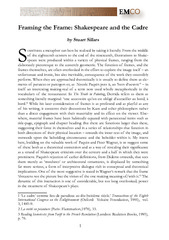| dc.contributor.author | Sillars, Stuart | |
| dc.date.accessioned | 2016-07-05T08:41:59Z | |
| dc.date.available | 2016-07-05T08:41:59Z | |
| dc.date.issued | 2010 | |
| dc.Published | Early Modern Culture Online 2010(1):1-11 | eng |
| dc.identifier.issn | 1892-0888 | |
| dc.identifier.uri | https://hdl.handle.net/1956/12258 | |
| dc.description.abstract | This article provides a conceptual introduction to the notion of Framing and functions as an introduction. n Framing the Sign, Jonathan Culler privileges the term frame over context (ix). Culler states that framing a work of literature implies literary analysis whereby the agency of the critic determines the meaning of that work, whereas context is something that is already given. While frame invites the interpretations of complexities separate from the surrounding space in which the work of literature exists, context directs us “to slip back into the model it proposes’; it thus simplifies analysis because it presumes that some of the meaning in the work of art is already known. | en_US |
| dc.language.iso | eng | eng |
| dc.publisher | EMRG | eng |
| dc.rights | Attribution CC BY | eng |
| dc.rights.uri | http://creativecommons.org/licenses/by/3.0/ | eng |
| dc.title | Framing the Frame: Shakespeare and the Cadre | eng |
| dc.type | Peer reviewed | |
| dc.type | Journal article | |
| dc.date.updated | 2016-04-11T05:59:33Z | |
| dc.description.version | publishedVersion | |
| dc.rights.holder | Copyright 2010 The Authors | eng |
| dc.identifier.cristin | 531277 | |
| dc.subject.nsi | VDP::Humaniora: 000::Litteraturvitenskapelige fag: 040::Engelsk litteratur: 043 | |
| dc.subject.nsi | VDP::Humanities: 000::Literature: 040::English literature: 043 | |

